Report

At a Glance
- Bain, AliResearch, and Baidu Research identified three common factors in a company’s digital success: speed, personalization, and innovation.
- China has a unique platform business model, which we define by four attributes that help companies lead in digitalization: resource aggregation, maximizing data value, technology enablement, and operational enablement.
- We look at three participation models—partnership, hybrid, and self-build—that can help companies initiate change in their organization, their operating mechanisms, their talent, leadership and culture, and their tech and data systems.
Executive summary
Since 2008, China’s digital economy has experienced years of booming development driven by the rapid evolution of mobile Internet technology, government-led investments, and digital-savvy consumers.
According to the China Academy of Information and Communications Technology (CAICT), China’s digital economy grew at a compound annual growth rate of 20% from 2008 to 2019. This digital economy has become one of the largest in the world, hitting RMB 31 trillion and ranking second in the world in 2018.
Covid-19 caused digitalization to be taken up a notch in China. Bain’s latest study shows that Covid-19 has accelerated digitalization in China by driving the creation and adoption of digital applications in areas such as online shopping, online education, and remote working.
Facing such a shifting digital landscape, what key success factors (KSFs) have digital champions in China demonstrated? What else has shaped them? Why has China, specifically, experienced such significant growth? How should Chinese companies use the platform business model to ride this digital wave in China?
At this critical transformational juncture, Bain & Company, AliResearch, and Baidu Development Research Center worked together—using Bain & Company’s deep management consulting expertise across industries and the vast case libraries of Alibaba and Baidu—to identify three common KSFs that digital champions in China have demonstrated: speed, personalization, and innovation.
We have gone a step further to identify the unique platform business model in China as the secret behind the digital transformation driven by the above KSFs. This unique platform business model is defined by four attributes that help companies lead in digitalization: resource aggregation, maximizing data value, technology enablement, and operational enablement.
That led us to a fundamental question: Why is the unique platform business model so prevalent in China? Our research points to four major reasons. First, the government has laid a foundation with investment in digital infrastructure and structural reforms on both the supply and demand sides. Second, China has a digital-savvy consumer base that is relatively more tolerant of data sharing and utilization, which has helped create large databases and use cases that accelerate digitalization. Third, companies distressed by highly fragmented supply and demand resources or less-developed technology and operational capabilities have sought external support to solve those challenges. Lastly, platform players (mainly Internet giants) with the willingness and capabilities have emerged as enablers to help companies break through bottlenecks.
To get the most out of the unique platform business model in China, we advise companies to make the right choice based on their characteristics and overall digital transformation planning. In practice, we have observed three participation models: partnership, hybrid, and self-build, each with successful examples. After picking the right participation model, leading companies refine their path to digitalization by kicking off changes to four key areas of their operating model: their organization; operating mechanisms; talent, leadership and culture; and tech systems and data.
Looking ahead, the changing business environment has brought more opportunities for the unique platform business model in China as well as stretch goals for all stakeholders. Meanwhile, the Chinese government is also focusing more robustly on the development of platforms. China’s 14th Five-Year Plan emphasizes technology innovation while advocating demand-side reform to unleash consumer demand. In addition, China is refining policies and regulations to equip the platform business model with supervision, aiming to uphold both vigor and order.
Now is the time for companies and platforms to seize their opportunity in this growing digital economy. Those that emerge as winners in this next era will set stretch goals for becoming even faster, more personalized, and more innovative to achieve healthy and sustainable development.
Three key success factors of digital champions in China
From fragmentation to supply aggregation, from homogenization to micro-segmentation, from a single- to a multi-pronged approach, our study has found that digital leaders in China share three key success factors (KSFs) in the wave of digitalization: speed, personalization, and innovation (see Figure 1).
China’s digital leaders possess three KSFs: speed, personalization, and innovation


Speed
The digital economy and the consumer products industry are intertwined. As the so-called “new oil” in the digital era, data creates momentum for companies to achieve record growth.
Take the snack food industry. On top of its low barriers to entry and high level of homogeneity, it also faces challenges in supply chain integration given the extended value chain. As competition heats up, in order to overcome supply chain fragmentation, Bestore has built a strategic partnership with Alibaba to aggregate its fragmented supplier and customer bases. More than 260 suppliers, along with a handful of logistics partners, are now fully integrated to handle more than 1 million orders per day, reducing end-to-end supply chain response time by 50% and delivering from farm to shelf within about seven days. On the demand side, about 70 million product data points are fed upstream to guide product R&D and innovation. In terms of sales and marketing, Bestore focuses its efforts on online channels including Taobao Live, Youku, Sina Weibo, and Tmall’s flagship store. The brand now counts more than 97 million followers or members thanks to traffic aggregation.
A powerful front end would not be possible without robust support from the back end. With the help of Alibaba’s tools, Bestore aggregated its fragmented supply and demand bases. As a result, Bestore shortened its product development cycle to one-third of the industry average. It now launches more than 300 products per year (see Figure 2).
Alibaba’s aggregation of highly fragmented supply and demand enables Bestore to achieve faster product development

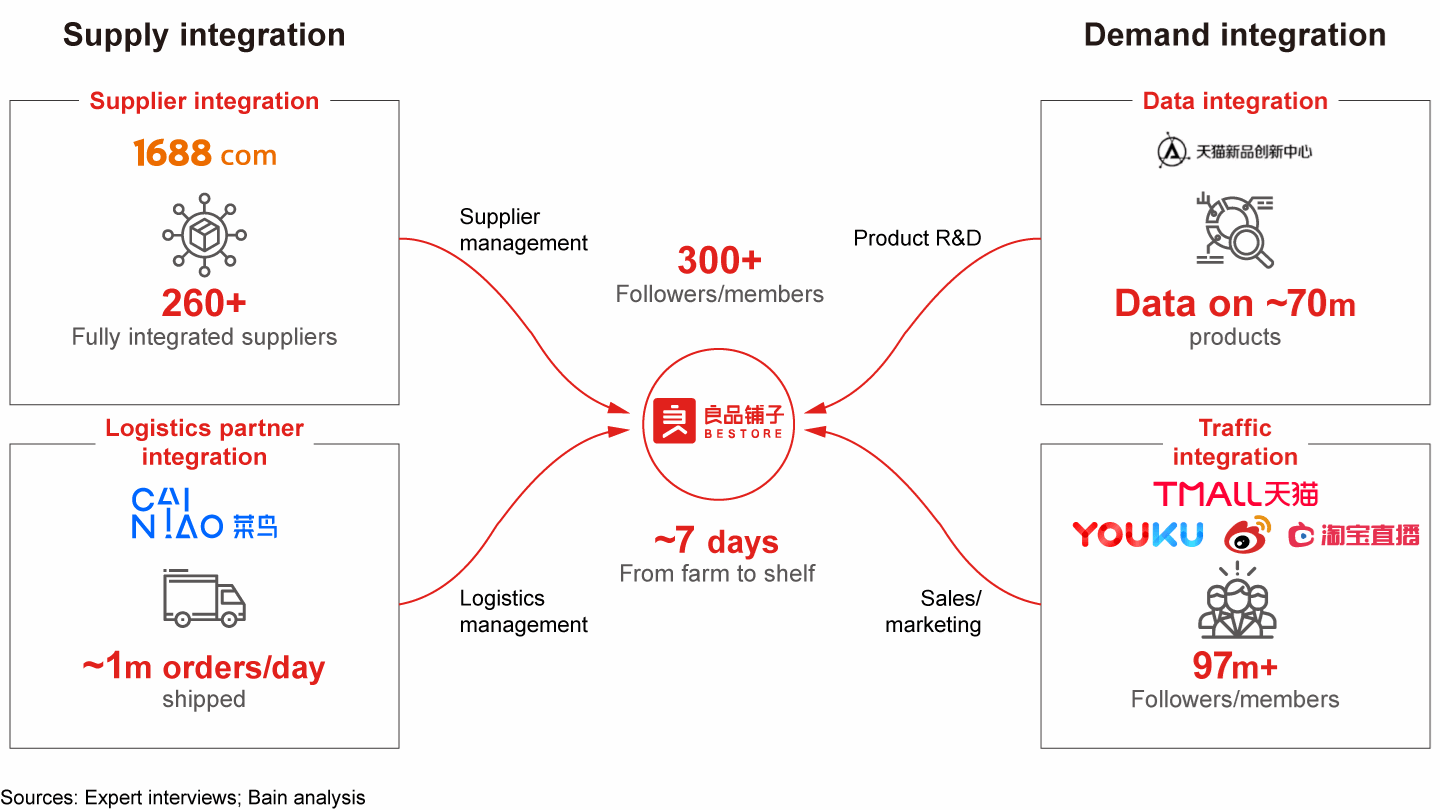
Personalization
As consumer demand has become increasingly personalized in recent years, companies are facing the imperative to provide individualized products and services for different customer segments.
Research shows that data and technology help companies achieve precision marketing across different customer segments. Consider beauty giant L’Oréal, for example. First, it combines Alibaba’s online browsing, consumption, payment, and feedback data on beauty products with L’Oréal’s target consumer and operations data, as well as information derived from more than 30,000 websites every day. Then, the company generates insights about consumers to identify eight customer segments based on characteristics such as demographics, interests, social behaviors, online shopping behaviors, and offline transactions. Finally, L’Oréal splits content into elements useful for individualized marketing.
Micro-segmentation helps companies better target consumers. Supported by the data accumulated in the Alibaba ecosystem, L’Oréal deploys individualized marketing to micro-segments of customers. This helped the company achieve a click-through rate that is 50% to 100% higher than the industry average, boosting sales through conversion rates that are about three times higher than before.
Internet radio company Qingting FM is also committed to individualized product offerings. For example, Qingting FM uses Baidu Development Research Center’s technology to help it collect user engagement data (e.g., user profile, play history, habits, and location). It has also used Baidu Development Research Center’s artificial intelligence (AI)-driven intelligent recommendation technologies, such as speech recognition and knowledge mapping, to establish an occasion-specific labeling system and match users with relevant content. For example, if a user is listening to Qingting FM in the car, the company will push broadcasts of road condition information based on the car’s real-time location.
The idea is to know your customers even better than they know themselves. Qingting FM offers individualized audio streaming to 130 million monthly active users, boosting users’ willingness to pay and increasing revenue from paid members by 300% over the last two years (see Figure 3).
Technology from partners such as Baidu Development Research Center helps Qingting FM offer individualized audio streaming to users

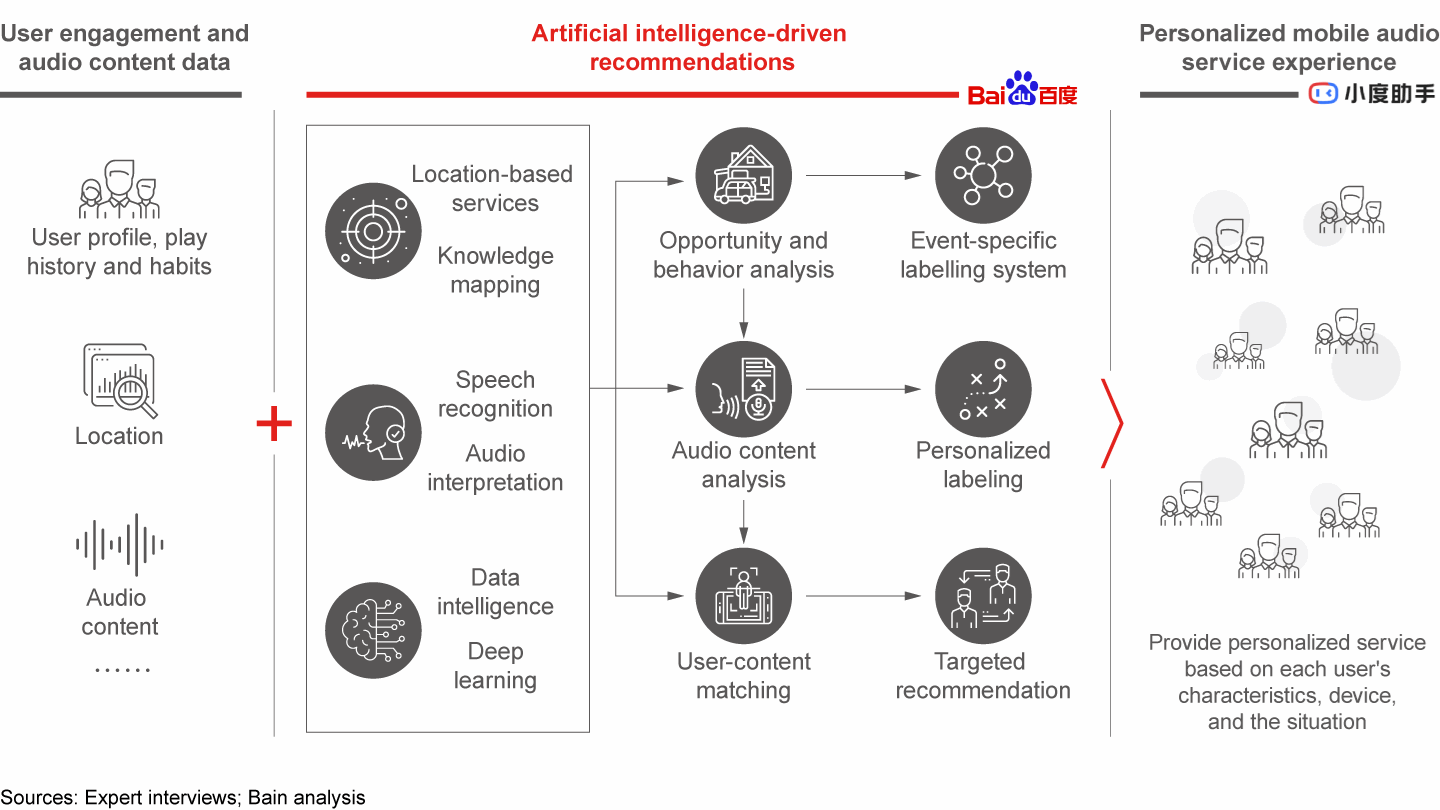
Innovation
Digital transformation means more than just technological iterations for companies. More important, technology can play a role in reshaping existing businesses with innovative products, services, and business models to create new growth opportunities.
In this wave of digitalization, traditional manufacturers are among those winning with innovation. For example, King Long built a product platform powered by local technologies. It has coupled its automotive manufacturing experience with Baidu Development Research Center’s Apollo autonomous driving and AI technology, sensors, and HD maps, as well as support from Baidu Development Research Center’s engineering team. Moving forward, both parties will continue their exploration and iterations of autonomous driving. On the one hand, King Long aims to speed up iteration of existing product features to support multiple operating models, including buses and taxis, to address different scenarios. On the other hand, the company plans to combine internal telematics data with external technology capabilities to transform from a traditional car maker into an integrated solution provider offering a variety of services to business customers.
With the help of Baidu Development Research Center’s autonomous driving technology, King Long has become the first in the world to mass-produce level-4 driverless buses. In two years, its fleet has logged 100,000 kilometers driving in a closed environment and carried 100,000 passengers with zero accidents so far.
We have also seen NIO and Starbucks demonstrate innovation. Starbucks China joined forces with Alibaba to enhance Starbucks Delivers mobile delivery and Starbucks Now mobile order and pay services, leveraging the latter’s capabilities across the value chain from traffic generation to service enhancement. Mobile ordering sales soared to 26% of Starbucks China’s business for the quarter ending September 2020. During this process, Starbucks connected to new platforms (including Ele.me, Koubei, Fliggy, Amap, Alipay, and Taobao), created new ordering options for customers, and expanded customer touchpoints, while delivering a more seamless online-to-offline experience for its customers.
In its 21-year journey in China, Starbucks has upheld its passion for coffee and commitment to quality and service. The company has worked with strategic partners to drive continuous innovation and elevation of the customer experience.
Its commitment to quality is reflected in the creation of Starbucks Delivers, an online delivery service launched in September 2018. The company designed a delivery-specific menu, customization options, and packaging to bring the same in-store coffee quality and consistency to Starbucks delivery customers. Ele.me created a hot-and-cold delivery system to maintain optimal beverage temperature during delivery. To minimize delivery time, Ele.me provides designated riders to Starbucks stores and uses its smart dispatching system to optimize routing for each order based on real-time data and analytics.
In May 2019, Starbucks launched its Starbucks Now service, allowing customers to place orders online and pick them up at a Starbucks store. An uplifting message is given for each order as a “secret code” for collection, a touch that often brightens customers’ day and adds a moment of connection with Starbucks employees. In July 2020, the Starbucks Now service expanded from the Starbucks app to multiple platforms including Alipay, Taobao, Koubei, and Amap in an effort to offer customers greater convenience. In addition, a new function allowed customers to order ahead and set a specific time for picking up their orders.
In July 2019, the first Starbucks Now store opened in Beijing, offering a new retail format that integrates the chain’s physical and digital touchpoints. Combining the traditional Starbucks café environment with Starbucks Now and Starbucks Delivers, the streamlined experience aims to bring more convenience to customers and delivery riders. The concept subsequently rolled out to more cities including Shenzhen, Shanghai, Guangzhou, Tianjin, Hangzhou, Chengdu, Nanjing, and Wuhan.
By the end of September 2020, Starbucks Delivers was available in 84% of Starbucks stores on the Chinese mainland and Starbucks Now services were available in 98%.
Unlike the traditional car dealership model that relies on a single touchpoint, NIO’s approach spans the car services value chain in an effort to enhance user engagement across the product life cycle. The NIO app is used as the hub to engage with users while the NIO community releases brand-related information to attract new users and generate traffic, all while offering financial service products to enhance the user experience. NIO Space, the company’s physical showrooms, give consumers the opportunity to test-drive and purchase vehicles. In addition, the NIO Service Center program enables customers to purchase vehicle repair and battery-charging services on demand through the company’s app, and NIO field technicians go to customers’ locations to perform the work. Meanwhile, a variety of auto parts and derivatives are available in NIO’s in-app shopping mall. Lastly, NIO House hosts events to engage with NIO customers, increasing user stickiness and lifetime value and enhancing operational enablement across the end-to-end value chain.
The secret ingredient: The unique platform business model in China and its four attributes
By delving into various examples across sectors, we have identified the unique platform business model in China as the secret behind the nation’s fast digital transformation. The platform business model has four attributes (see Figure 4).
The unique platform business model in China has four main attributes

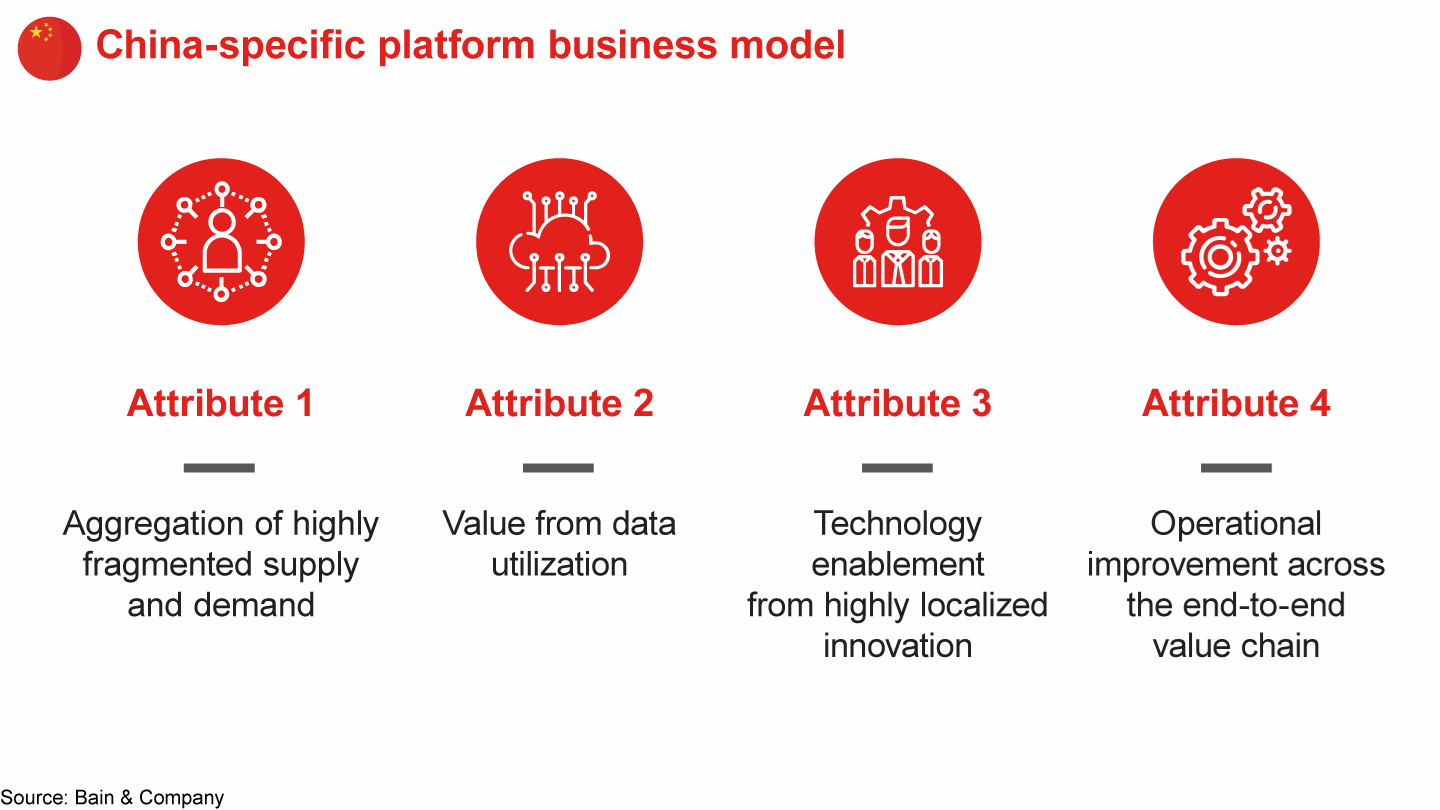
Resource aggregation
Efficient supply and demand resource aggregation and matching has always been a priority for businesses. By pooling supply resources and matching with demand resources, companies can enhance overall operational capability and create more value. Therefore, the unique platform manages to pool and match scattered external resources of supply and demand in an open and inclusive way, including technology, products, services, and traffic.
For example, Bestore has partnered with Alibaba to help it aggregate a large number of suppliers and differentiated consumer demand to reinforce Bestore’s competitiveness in data. Bestore has built a new end-to-end operating model that halves its response time and triples its speed of new product development.
Maximize data value
In the digital era, the unique platforms leverage user data to build end-to-end data interfaces and iterate technology to develop data tools that apply to multiple scenarios and maximize data value of two-way data flow.
L’Oréal is one example. Using Alibaba’s platform to help aggregate large amounts of data, L’Oréal changed from a dovetailed approach to micro-segmentation to maximize data value and reach target customers with individualized marketing.
Technology enablement
In their efforts to transform and invest in the digital economy, the unique platforms have developed technology tailored to the local market while exporting these new technologies in forms that can lower barriers to innovation.
For example, Baidu Development Research Center’s technology has helped Qingting FM offer individualized audio streaming to its 130 million monthly active users. Meanwhile, King Long has developed the world’s first mass-produced level-4 driverless bus.
Operational enablement
The unique platforms engage in end-to-end operations, on top of technology sharing, to offer integrated solutions and support execution.
For example, Starbucks’ digital retail innovation initiatives include creating an integrated online and offline experience supported by Alibaba’s capabilities across the value chain. NIO has built its own online community to embed innovation across the automotive value chain and scenarios.
Why in China: Four major reasons behind the success
As we reviewed the digital transformation journey of digital champions across industries, we found that these companies derived value by combining their own resources with those of the external business environment and by forming partnerships with complementary unique platforms.
Our research has further zoomed in on the unique platform business model in China to identify four major reasons that shape it (see Figure 5).
Four major reasons shape the unique platform business model in China

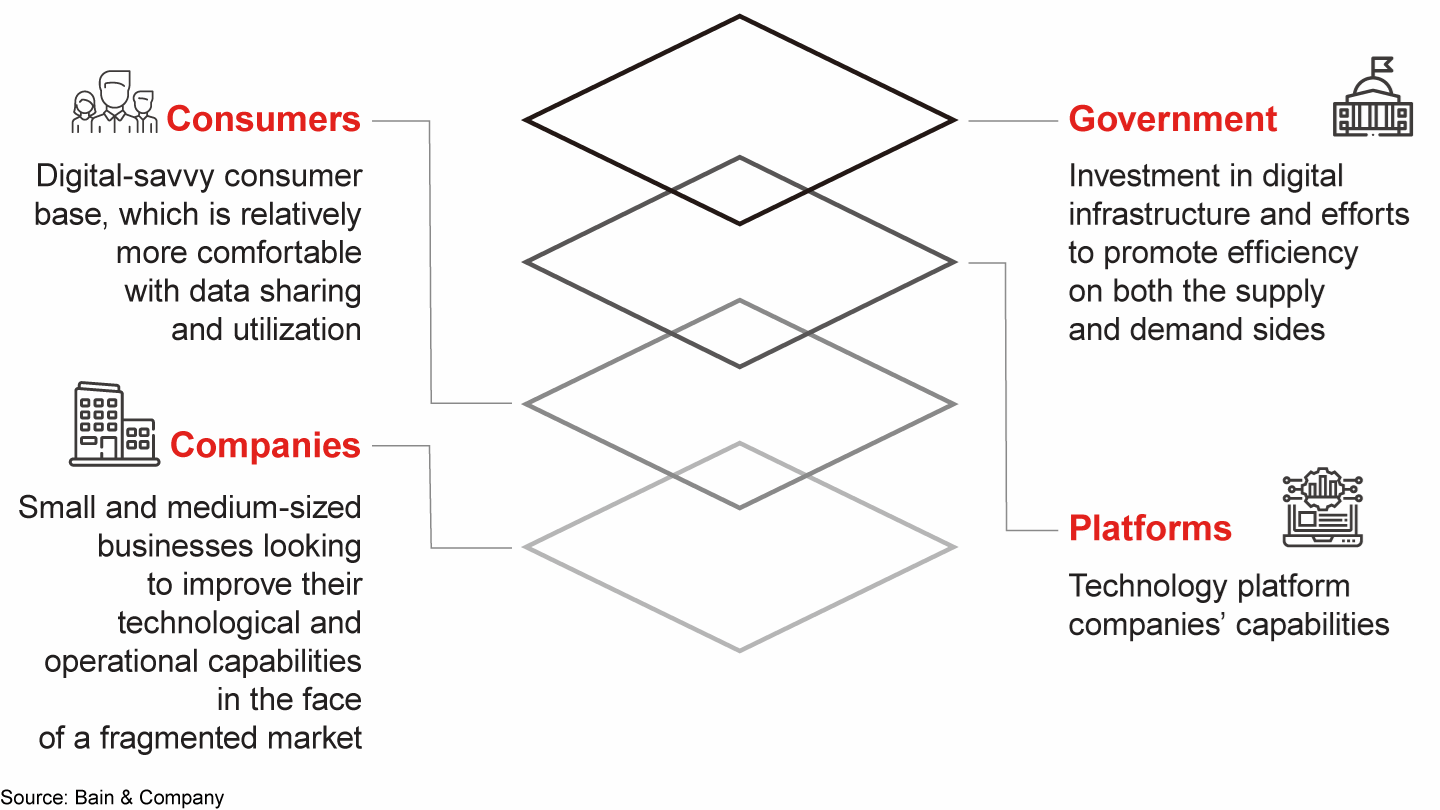
The government has invested in digital infrastructure and promoted efforts to boost efficiency on both the supply and demand sides. Sustainable growth needs a solid foundation. In recent years, the Chinese government has directed investment into digital infrastructure—including 5G, big data, and AI—to drive value creation from data utilization and technology enablement from highly localized innovation.
According to International Data Corporation (IDC) and our literature research, from 2016 to 2019 China built 140,000 5G base stations, deployed 1.19 million data center racks, and invested around RMB 320 billion in AI technology; it also achieved approximately 92% optical fiber penetration among broadband subscribers by the end of 2019. Notably, the Chinese government is doubling down on its investment in new infrastructure as a strategic priority for driving the digital economy. According to estimates, in 2020 China built 580,000 5G base stations, deployed 930,000 data center racks, invested about RMB 100 billion in AI technology, and achieved approximately 95% optical fiber penetration among broadband subscribers.
Meanwhile, the government has implemented structural reforms on both supply and demand to facilitate efficient resource aggregation.
China’s digital-savvy consumer base is relatively more tolerant of data sharing. China has the world’s largest Internet-user base, which creates value from data utilization and provides favorable conditions for the digital economy. Moreover, the government is taking steps to tighten regulation on data protection, which could help consumers feel more comfortable about data utilization and create new use cases for operational enablement across the end-to-end value chain (see Figure 6).
China’s digital-savvy consumer base creates opportunities for technology companies

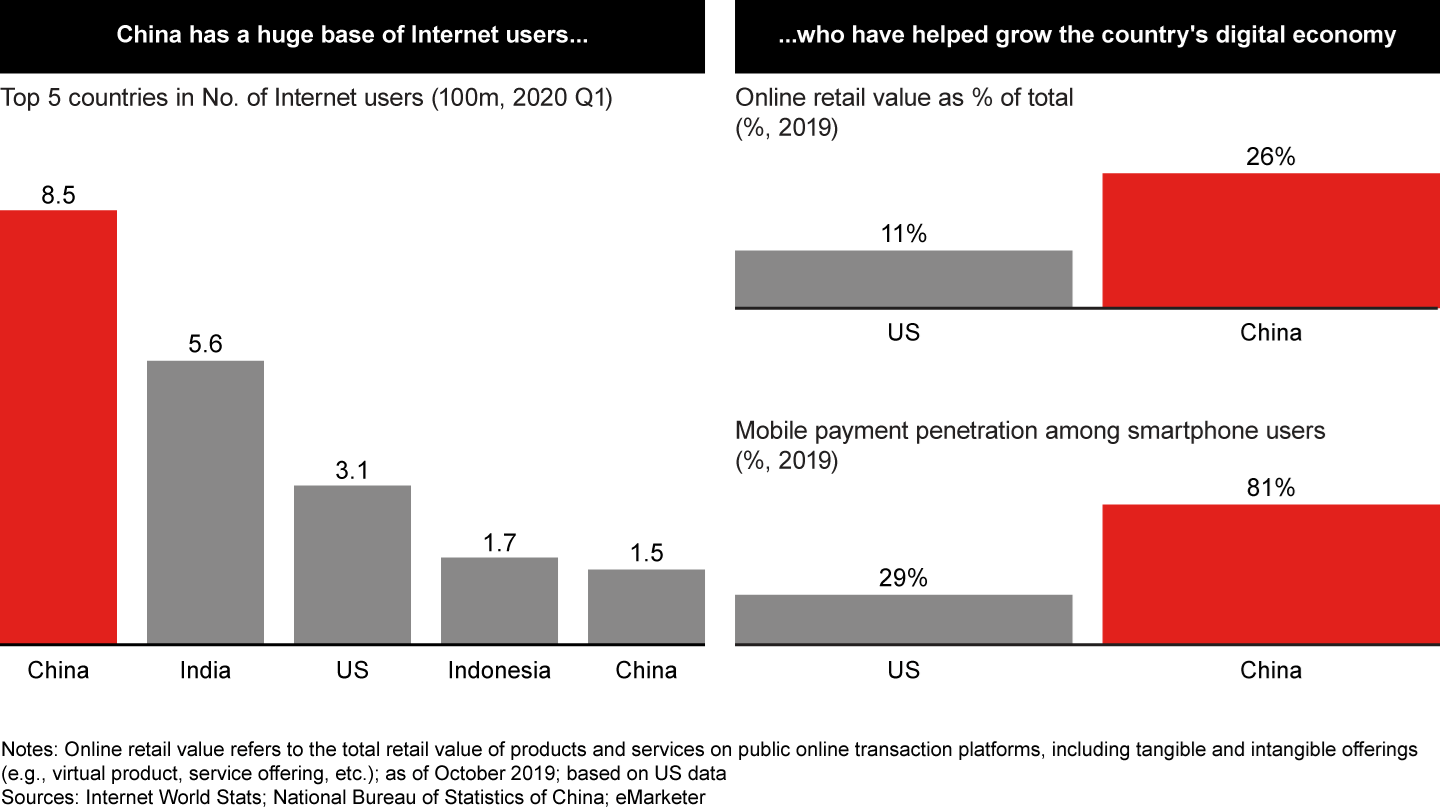
As of the first quarter of 2020, the number of Internet users in China hit 850 million; for comparison, India has 560 million Internet users and the US, 310 million. Another sign of Chinese consumers’ digital-savviness is their pursuit of a convenient lifestyle made possible by innovative technology and Internet platforms. In 2019, China’s rate of online retail sales was 2.4 times that of developed nations, while smartphone users in China used mobile payments 2.8 times more often than those in the developed world, according to the National Bureau of Statistics of China and eMarketer.
What’s more, the government is getting more stringent about data management. Since 2016, China has promulgated a number of laws, such as the China Cybersecurity Law, which concerns the framework of the legal system and requirements for private data protection; the China Data Security Law (Draft), which concerns the fundamental rules of data security protection; and the Personal Information Protection Law of the PRC (Draft), which concerns personal information handling based on prior notification and consent. These ongoing efforts to improve the legal system could contribute to stronger consumer confidence in data utilization.
China’s base of small and medium-sized businesses want to improve their technological and operational capabilities in the face of a fragmented market. While government support and potential market size growth in China have created a favorable external environment, Chinese companies—predominantly small and medium-sized businesses (SMEs)—still face daunting challenges. Most notably, many lack fundamental technology and operational capabilities and are struggling with highly fragmented supply and demand bases. Increasingly, these companies are turning to technology platforms to help them overcome these challenges
- Challenge 1: Aggregation of supply and demand. On the supply side, Chinese companies, regardless of sector, have a more fragmented supply base than developed nations. In 2019, the combined market share of the top five companies by sales revenue in retail, snack, and personal care in China was lower than that of all three industries in developed nations. Furthermore, in 2018, the total production of the five largest coal and steel companies in China was more than 20% lower than both industries in developed nations (see Figure 7). On the demand side, China’s urban-rural income and regional income gaps are, respectively, two and three times wider than those of developed nations. Such an uneven income distribution has led to diversified demand.
Historically, offline channels have struggled to aggregate supply and demand. However, the unique platform business model in China could help solve these long-standing challenges. On the one hand, it provides companies with more options and better transparency to see the “big picture.” On the other hand, it helps suppliers build scale and minimize investment in offline expansion for better cost and efficiency. On top of that, platforms can leverage intelligent algorithms to drive precise matching between supply and demand to boost efficiency. - Challenge 2: Technology capability gap. Technology enablement is instrumental to building a digital economy. Chinese companies are increasingly looking for ways to improve their digital capabilities as the digital economy grows. In addition, compared with developed nations, companies in China are more dependent on technology enablement by external platforms due to limited information technology (IT) spending, an R&D talent shortage, and insufficient funding for fundamental technology development (see Figure 8).
Chinese companies invest less in IT; for example, they spent 1.8% of GDP on information and communication technology (ICT) in 2019 compared with 4.1% in developed nations. Talent is a precious, intangible asset for companies. However, in 2017 China had only 1.2 top AI researchers for every 1 million employees, far behind the level in developed nations. In terms of financing, Chinese investors tend to prefer investment in the application technology to infrastructure technology. Therefore, many Chinese companies rely on platforms for fundamental technology innovation tailored to the local market. - Challenge 3: Operational capability gap. The majority of businesses in China are small and medium-sized. Take industrial companies, for example. In 2018, only 2% of industrial companies in China were large corporations generating more than RMB 400 million in annual operating revenue, according to the National Bureau of Statistics in China.
Small and medium-sized companies face multiple challenges in their digital transformation, especially a talent shortage. The traditional talent development model is too slow to keep up with changes in companies, while externally hired digital employees are less familiar with companies’ internal operations. Companies also face such challenges as high operational costs and poor transparency on operating data, resulting in an operations gap. This creates an opportunity for platforms to support operational enablement across the end-to-end value chain (see Figure 9).
Specifically, digital talent in China is mainly devoted to product R&D, which accounts for 87% of the total digital workforce. This leaves few in digital operations or digital strategy management, which account for 7% and 1%, respectively.
This talent gap results in poor data operations within most small and medium-sized businesses. As we found in our study, these companies collect too little operational data to boost productivity with digital tactics. Furthermore, the fragmented value chain makes it even harder for companies to access external data from upstream and downstream.
Finally, subscale companies find it hard to achieve economies of scale in operation, which leads to higher operating costs.
A fragmented supply chain and uneven demand present challenges to many Chinese companies

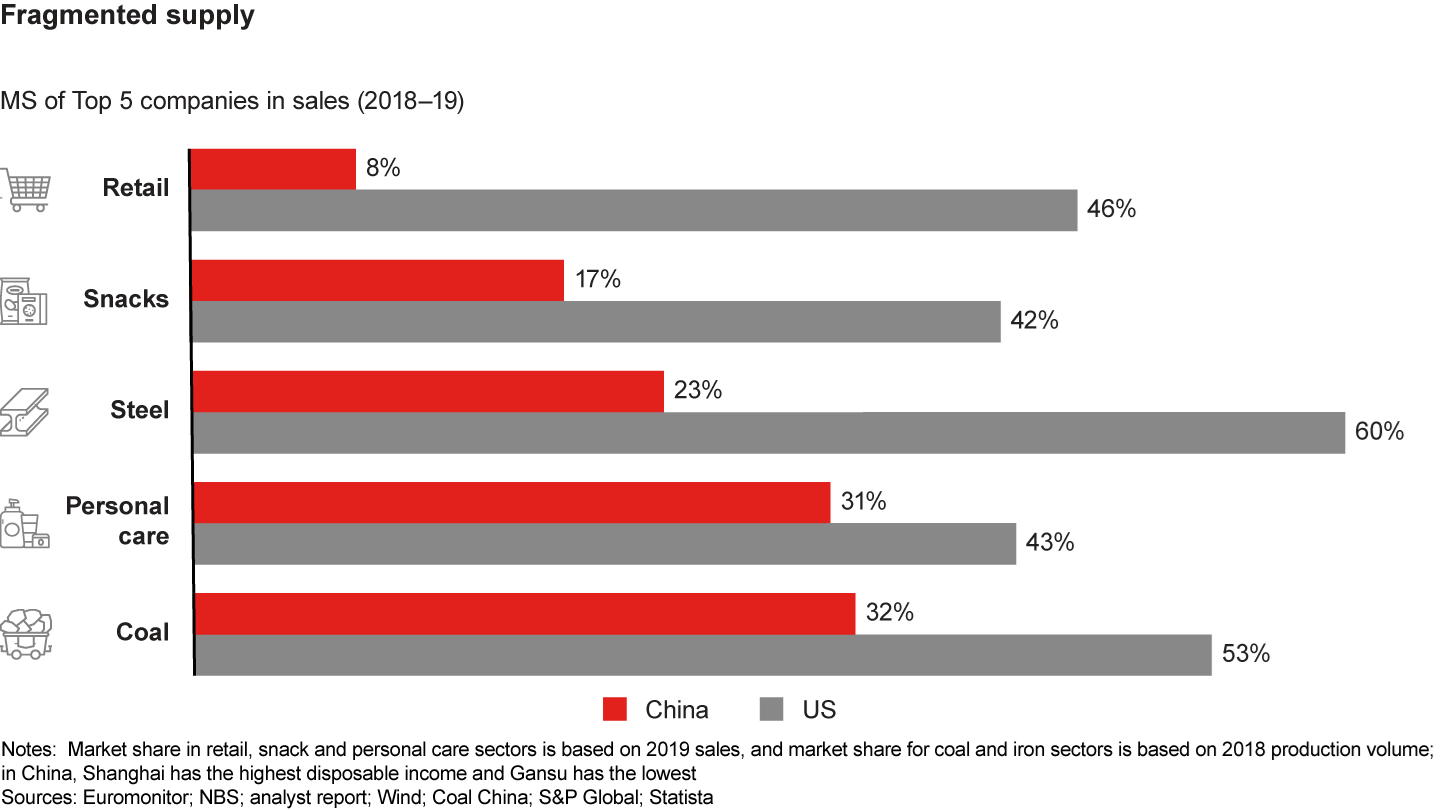
Many Chinese companies are suffering from gaps on IT capabilities

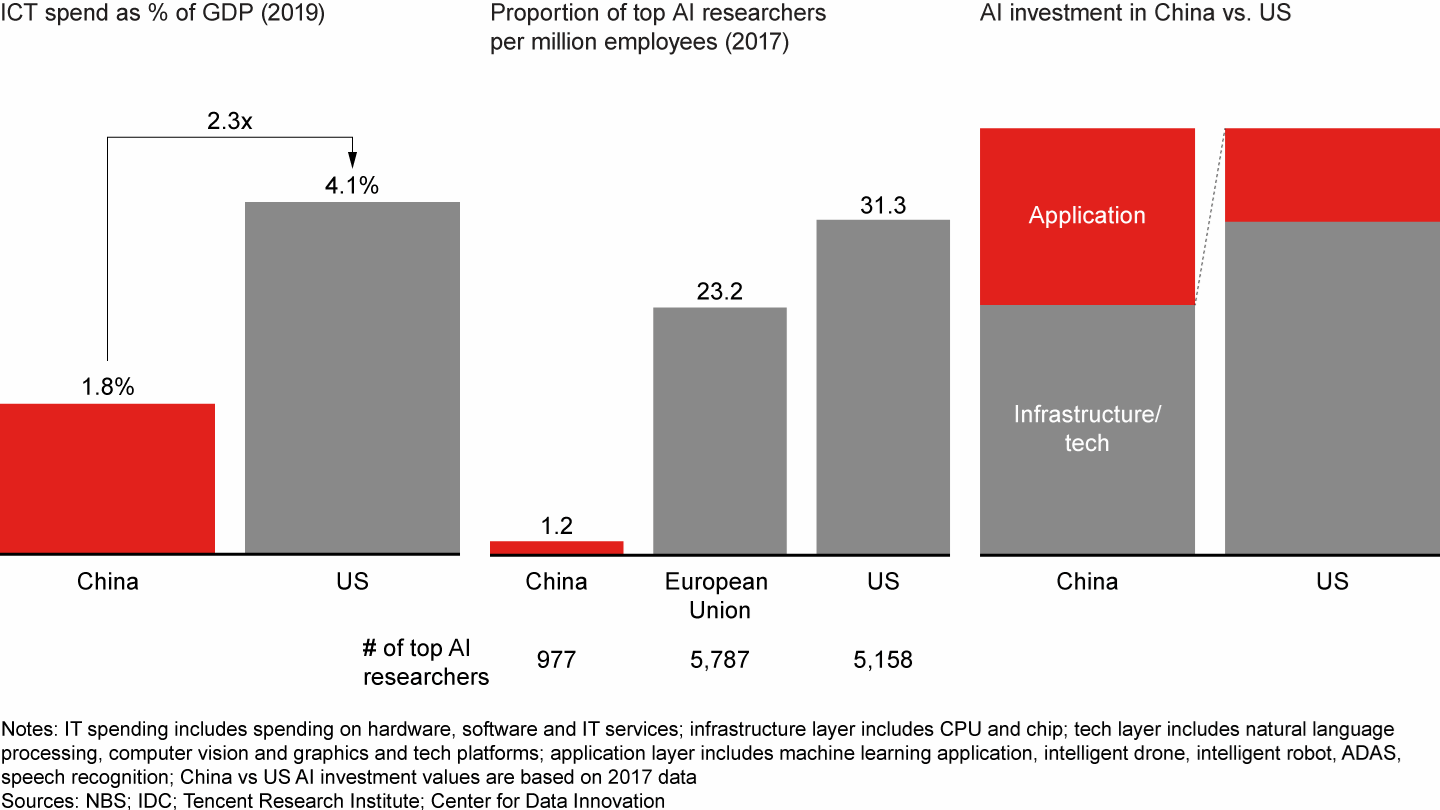
The majority of Chinese companies are SMEs with gaps on operating capability

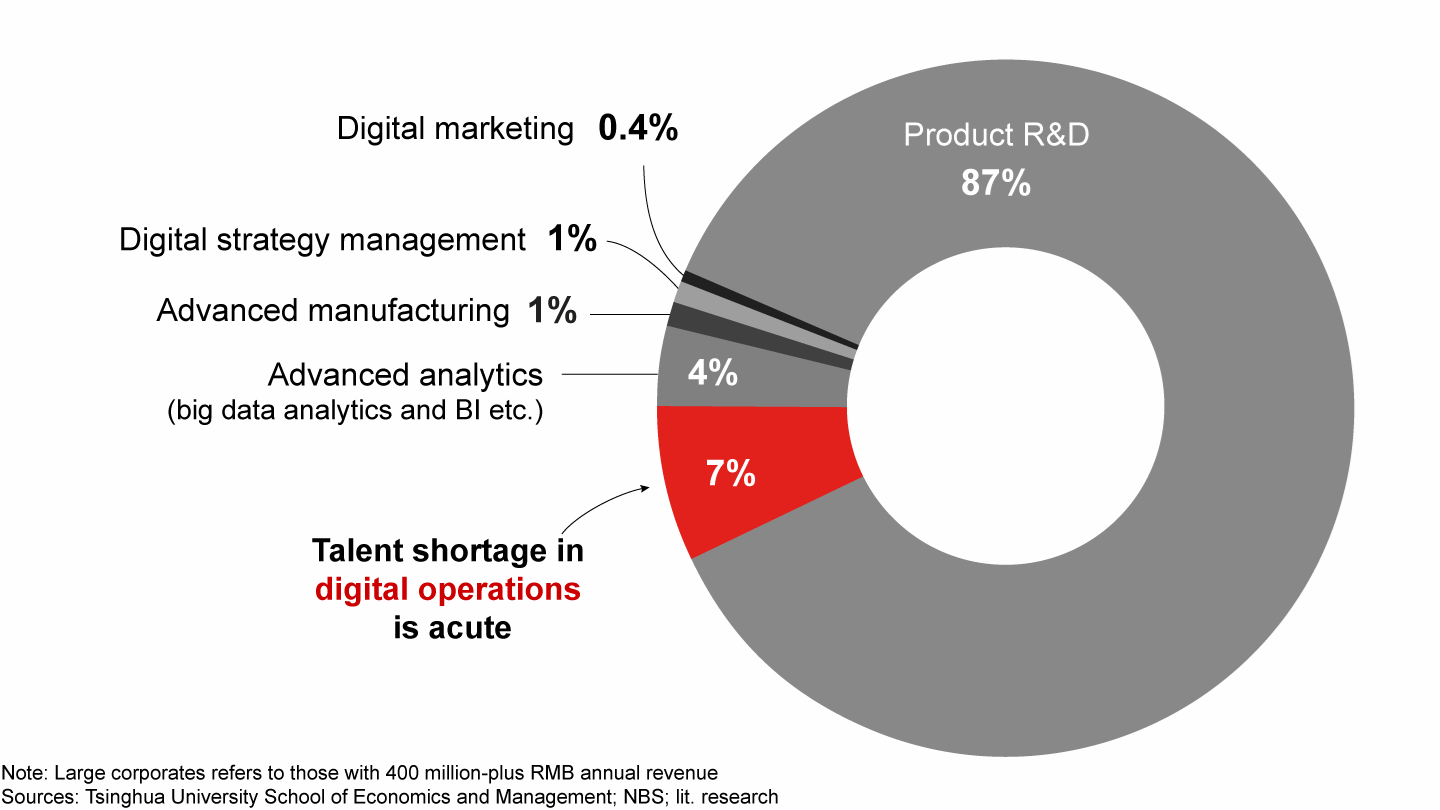
Strong platform players are pushing the platform business model. Technology platform players (mainly Internet giants) have an important role in advancing China’s digital ecosystem. Their scale, technology, and talent allow them to provide services to address companies’ pain points in technology and operations.
First, platform players in China generally are large in scale, which helps partners and customers improve operational efficiency and reduce cost. Second, platforms in China have a solid talent pool. Internet platform companies have attracted nearly 50% of the market’s digital talent with strong branding and compensation, according to the Tsinghua SEM Center for Internet Development and Governance. Third, Internet platform companies in China have an established track record of developing new technologies. Take AI patents as an example: In 2020, Baidu Development Research Center had the largest number of AI applications in China with 9,364 filings; Tencent ranked second with 8,450 filings.
Drawing on those three advantages, platforms in China can provide companies and consumers with digital services across the value chain, covering marketing, payments, logistics, and supply chain or production. For instance, Baidu Development Research Center provides companies with end-to-end digital marketing solutions such as traffic monetization and precision marketing with access to approximately 900 million Internet users. Alipay’s mobile payment services have more than 1 billion annual active users. JD Logistics established a network that reaches more than 550,000 Chinese villages, with 92% of districts and counties and 83% of townships in mainland China receiving its 24-hour delivery service. Alibaba’s algorithm-driven, digital supply chain optimization services help merchants increase the efficiency of their supply chains through data visualization, customer-product matching, inventory optimization, and store digitization.
On top of their digital capabilities, platforms in China are well positioned to take the data value, operational experience, and advanced technology they have accumulated while serving consumers and apply those assets to the enterprise business world and other new growth engines.
Since 2000, the consumer Internet has gradually moved from PCs to mobile devices, and the industrial Internet has also been growing. We expect that, as consumer-facing business plateaus, opportunities to serve enterprise and government customers will emerge with even bigger potential. Internet giants are scrambling to build a stronger presence with their business offerings through the introduction of cloud platforms (e.g., Alibaba Cloud, Tencent Cloud, Baidu Cloud, and JD Cloud) and big data platforms (e.g., Alibaba-backed MaxCompute, Baidu DI, Tencent Big Data, and JD Big Data). AI platforms, like Alibaba’s ET BRAIN, Baidu AI Open Platform, Tencent AI, or JD AI Open Platform, accelerate adoption of AI use cases, while DingTalk and Tencent Meeting play a role in facilitating office collaboration.
Governments such as the EU and China are responding to the growth of platforms with new policies and regulations. Their approaches seem to indicate three overarching goals: define platforms’ social responsibilities and legal obligations; develop regulatory measures aimed at promoting fair competition to maintain market order and foster local innovation; and work to protect user rights and access to safe products and services.
In December, the European Commission released proposals for the Digital Services Act and Digital Market Act to impose obligations on gatekeeper online platforms. The Digital Services Act aims to protect user security and clarify platforms’ obligations in the digital environment. It also defines the obligation of social media platforms to review and restrict illegal content, and it would create an accountability framework for Internet platforms. The Digital Market Act is aimed at fostering fair competition, healthy technology development, and local innovation. For example, the act would require platform companies to ensure fair competition between their own products and third-party products available on their platforms, and to safeguard the independence and security of competitor data to ensure fair competition between local companies and Internet giants.
The Chinese government is also making a regulatory push in this area. In August 2019, the State Council announced the Guiding Opinions on Promoting the Healthy Development of the Platform Economy, which highlighted the importance of the platform economy and signaled an intention to create a more level playing field that would promote disciplined and healthy platform development. In November 2020, China’s State Administration for Market Regulation (SAMR) released the draft Anti-monopoly Guidelines for the Platform Economy Sector to guide the compliance of platform companies and try to strengthen the health and sustainability of the online economy.
Implications: Three participation models and four key changes for enterprises to embrace
As the unique platform business model in China becomes more prevalent, it opens up new digital transformation opportunities for enterprises. We have seen that leading enterprises make differentiated choices based on their own characteristics and their overall digital transformation plans. In practice, we observed three participation models: partnership, hybrid, and self-build, each with successful examples (see Figure 10). After picking the right participation model, companies can refine their path to digitalization by kicking off changes to four key areas of their operating model: their organization; operating mechanisms; talent, leadership and culture; and tech systems and data.
Leading companies choose the right platform participation model based on their own characteristics and digital transformation plans

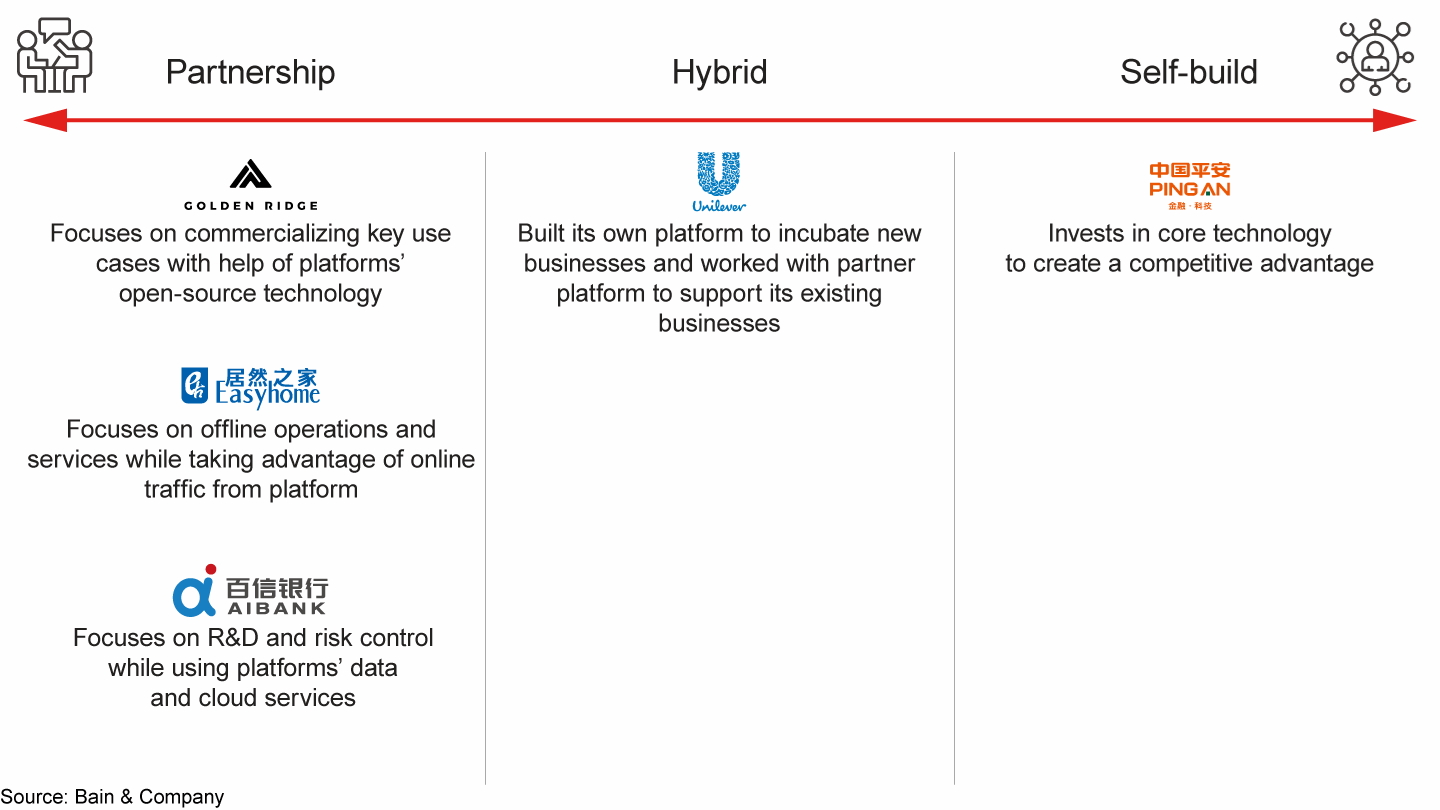
Participation Model 1: Partnership
Small and medium-sized businesses with limited resources—or even larger enterprises with resources that complement platforms—can leverage external platforms’ traffic, technology, and digital infrastructure to expand quickly and accelerate development of their digital capabilities. For example, CITIC aiBank focuses on R&D and risk control while leveraging platforms’ data and cloud services to offer customized digital financial services based on use cases.
For enterprises that follow this model, two key pieces of the strategy are focusing on the core elements of their value chain and leveraging the infrastructure that technology platforms deliver.
- Case 1: Golden Ridge focuses on commercialization while using Baidu Development Research Center’s open-source autonomous technology. In 2018, the AI and robotics-focused company Golden Ridge took the lead in launching an autonomous sightseeing vehicle for tourists. It was the first low-speed, manned, autonomous vehicle in China to meet the vehicle standards of the China Automotive Engineering Research Institute.
First, Golden Ridge developed a vision-centered multi-sensor that fused low-speed autonomous driving technology, chassis-by-wire, with a dual-electric engine and differential speed control, and Baidu Apollo’s autonomous driving-technology solution. This approach reduced hardware costs by more than 70% and kept the cost-per-vehicle about 33% below competitors’ costs, enabling Golden Ridge to achieve mass production. Finally, Golden Ridge used tools such as Baidu Brain and a smart voice platform to enhance human-computer interaction and continuously improve the product experience. In terms of commercialization, Golden Ridge has explored multiple-use cases such as the tourist sightseeing vehicle, scooters for healthcare centers, and customs inspection. It has begun to deploy the autonomous tourist sightseeing vehicle in a number of scenic spots. - Case 2: Easyhome focuses on offline store operations and services and uses Ali to drive online traffic. Easyhome, the domestic giant of home furnishing, has expanded beyond offline chain stores into the online trading platform Tongchengzhan. The company pursued this digital transformation with the help of Alibaba’s consumer traffic, data, and technology enablement capabilities.
-
In practice, Easyhome clearly delineated the roles of its online and offline channels. Offline stores provide services such as design support, in-person product testing and selection, in-store purchasing, product shipping, and door-to-door home installation and maintenance. Online channels focus on attracting traffic. Based on this, Easyhome and Alibaba jointly launched Shejijia, a design platform for home decoration and furnishing, to connect supply and demand in a timelier manner. With precise location information and intelligent recommendations, offline stores are now synced as city stations through the online Tongchengzhan platform for more convenient online and offline purchases.
In addition, Easyhome built a sales platform for smart home and household products, a sales platform for basic and supplementary decoration materials, and a platform for smart home decoration. It also provides services, including visible logistics and delivery and a door-to-door post-decoration service, to create a platform covering design, selection, and home decoration. The in-person experience is crucial for many consumers when purchasing furniture. Recognizing this, Easyhome leverages platforms’ online resources and digital technologies to drive online-to-offline integration and make the end-to-end core home furnishing business more digital.
Participation Model 2: Hybrid
Among large-scale enterprises that compete in relatively mature industries and have clear roles and responsibilities across the value chain, leading companies develop a refined digital strategy of building their own platforms. At the same time, many leaders also engage external platforms in order to realize mutual enablement, accelerate online sales growth, and accumulate user resources.
Regarding companies adopting this hybrid model, for startup businesses, enterprises could build their own platforms by aggregating supply and demand resources; for mature businesses, companies could work with external partners to accelerate growth.
- Case: Consumer goods giant Unilever built its own platform for incubating innovation while using external platforms and big data to enrich its own ecosystem. The two models are:
Startup businesses under the hybrid model. Unilever launched an external incubator in China, Unilever Excubator, to incubate new China-focused brands that entrepreneurs outside the company developed. Unilever also built a service platform that connects more than 1,000 original device and equipment manufacturers and 100 internal and external brands. This platform provides transparent, symmetrical market information for faster price inquiry and product matching. The platform also provides incubated brands with services in finance, marketing, and innovation.
For brands with high potential in Unilever Excubator, the company built a professional team with both internal and external experts in R&D, operations, and marketing, dedicated to providing point-to-point services and industry expertise for those brands.
Through this self-built platform, Unilever deploys the supply and demand resources it has accumulated over the years to incubate new brands and enrich the company’s ecosystem.
Mature businesses under the hybrid model. To support its existing businesses, Unilever struck a strategic partnership with Tmall Innovation Center. The partnership deploys Unilever’s in-house R&D capabilities with Tmall’s consumer data to quickly assess market demand and develop products that meet it. Unilever also built a flexible supply chain with support from Tmall. The consumer feedback Tmall collected, along with estimated market demand from Tmall’s trial sales, provide insights for Unilever to create and manufacture products on a “make-to-demand” basis.
Participation Model 3: Self-build
It might make more sense for a conglomerate with solid funding and technology to establish its own platforms that leverage its industry insights and vertical integration capabilities. At the same time, leading companies push their own boundaries and access more diverse customer touchpoints to enhance their own platforms.
The leaders that choose this approach tend to double down on key resources and capabilities to build their own platform as a moat against the competition.
- Case: Ping An Group digs into its core technology to build a moat. Ping An Group emphasizes research and development in core technology fields and works to create financial, medical, travel, real estate, and infrastructure services powered by AI, big data, cloud computing, and other technologies.
For example, Ping An Group set up an AI Institute to focus on the development and implementation of AI technologies that can be employed in multiple-use cases. In terms of big data, Ping An Technology built a platform that integrates underlying data-to-surface customer scenarios for life-cycle management with “one-stop” services. In terms of cloud technology, the company introduced Ping An Cloud in 2013 and launched a portfolio of infrastructure-, platform-, and software-as-a-service offerings to enable technology applications and vertical solutions.
As Ping An Group invested in core technology verticals—including AI, big data, and cloud technologies—it has notched achievements in financial, medical, travel, real estate, and infrastructure services. Specifically, it ranks first in China with the most fintech patents in 2020. The company’s patents are applied in its subsidiaries, including Ping An Property & Casualty Insurance, Ping An Life Insurance, and Ping An Bank. In the medical sector, Ping An won three championships at the International Symposium on Biomedical Imaging (ISBI) for AI-assisted medical imaging technology in 2019. This technology supports subsidiaries including Ping An Good Doctor, Ping An Wanjia Clinic, and Ping An HealthKonnect. The company transformed the AI-enabled Autohome from a content portal into an auto-service trading platform, and its market value has tripled since Ping An Group’s acquisition. The company’s core technology has also powered its real estate and infrastructure service solutions. Currently, its subsidiaries, including Ping An UCT, Ping An Fang, and China Merchants Ping An AMC, serve more than 95% of top-branded residences, enabling urban asset operations with tech. The company also launched Ping An Brain in Shenzhen, which CAICT selected as one of the Top 10 Smart City cases.
After picking the appropriate participation model, leading companies hone their operating model. They build a foundation and break through bottlenecks by making the following changes across these four dimensions: organizational positioning, operating mechanisms, talent management, and data management (see Figure 11).
Having picked their platform approach, leading companies sharpen their operating model with key changes across four dimensions

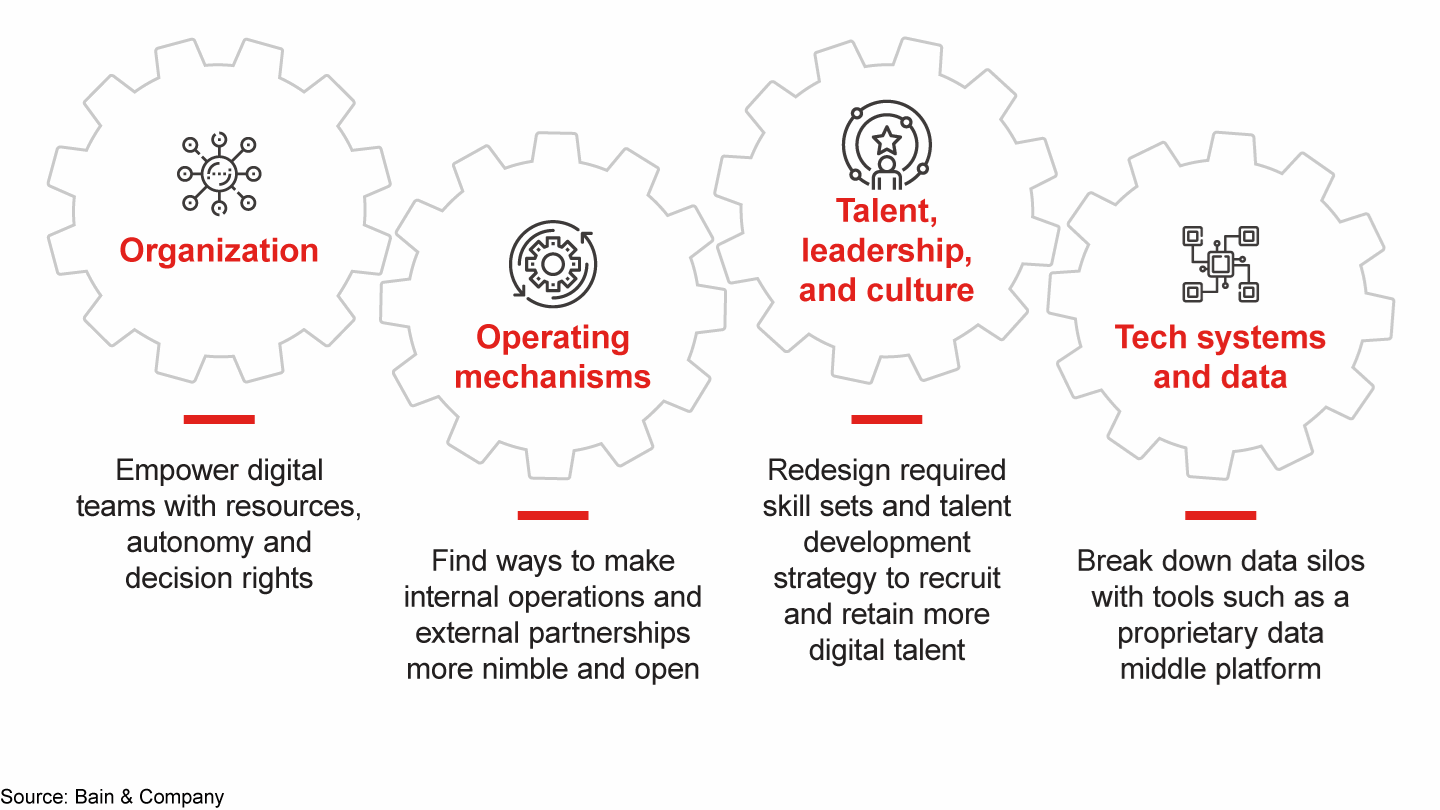
Organization: Empower digital teams with resources, autonomy, and decision rights to realize efficient resource allocation across supply and demand.
As mentioned above, a suitable platform can help an enterprise aggregate external supply and demand resources and improve supply chain efficiency. How an enterprise further brings into play the advantages of aggregated resources depends on organization management, which involves defining organizational positions, structure, powers, and responsibilities. Leading enterprises focus on the big picture by defining the blueprint for digital organization and, in practice, fully empowering digital businesses with resources and autonomy. This helps build a solid foundation for promoting the overall digital transformation.
Take the example of Starbucks China. The company took a holistic approach in driving its digital transformation, building digital into the context of its overall organizational structure. In June 2019, Starbucks China transitioned to a new business structure with two distinct business units, Starbucks Retail and Digital Ventures, with the latter reporting directly to the Office of the Chairman and CEO; Digital Ventures was also tasked with engaging external platforms for future development. According to John Culver, group president of international, channel development, and global coffee and tea, this structure enables a more agile organization and helps balance the short-term needs of the business with Starbucks’ long-term strategic priorities in China.
Digital Ventures focuses on driving incremental revenue by creating new customer demand and touchpoints. It has accelerated its digital innovation by embracing China’s Internet ecosystem and partnering with some of China’s leading technology giants to more effectively connect its products and services to meet emerging customer demand across various touchpoints.
For example, Starbucks Delivers™ serves online and group-buying customers, while Starbucks Now™ serves the needs of nearby online customers as well as offline customers looking for greater speed and convenience. Integration with external platforms—including Taobao, Alipay, Ele.me, Amap, and Koubei—enable access to acquire and serve new customer segments.
Operating mechanisms: Improving operating mechanisms with the help of platforms can result in operational enablement across the end-to-end value chain.
As the digital economy drives the transformation and upgrading of various industries, it requires enterprises to become more agile internally while also making external ecosystem partnerships nimbler and more open. This often involves collaboration with platforms to achieve operational enablement and boost efficiency across the end-to-end value chain.
For instance, King Long adopted a series of reforms to stimulate internal motivation and strengthen external ecosystem cooperation. Internally, in practice, King Long aims to break down functional silos by building cross-functional, nimble teams that cover vehicle design, manufacturing, use case design, quality control, and sales and marketing. King Long also set up a joint innovation center to attract external talent and build R&D capabilities to shorten its product launch time. Externally, for product development, King Long and Baidu Development Research Center formed a joint R&D team to develop a driverless car, taking less than two years from design to launch. This partnership continued with commercial, operations, and product iteration. For commercialization, King Long signed cooperation agreements with China Unicom and DTmobile to achieve 5G-enabled vehicle communications. In addition, King Long leverages ABB’s fast-charging system for its electric buses, promoting the development of electric transportation.
Talent, leadership and culture: Strengthen the talent development strategy to foster innovation.
Executives are well aware that talent is critical to any enterprise’s success. To strengthen their workforces, leading enterprises redesign their digital talent skills and talent development strategy to match the company’s talent mechanisms, leadership, and organizational culture. The goal is to better leverage tech enablement from localized innovation and maximize value from platforms’ data.
Beginning in 2016, Walmart doubled down on its omnichannel strategy and accelerated digitalization, which led the company to invest in its talent and culture. Walmart redesigned its talent evaluation model based on the needs of its digital transformation and personalized training and development plans. First, it defined role-specific competency requirements. The company redesigned the role profile and competency model based on different positions, such as store managers and procurement officers. For store managers, the focus was on building their digital thinking capabilities and capacity to promote innovations. The company also restructured the competency model for procurement officers from 25% for strategy, 40% for operation, and 35% for administration to 60% for strategy, 35% for operation, and 5% for administration.
In the era of the digital economy, Walmart also established a “3A model” specifically for talent assessment and identification, covering evaluation of employees’ ability, agility, and aspiration. This model identifies employees’ weaknesses and potential, aiming to cultivate open-minded thinking, effective collaboration, fast learning, and strong internal drive. Finally, Walmart launched its first mobile learning community, Woketang, in China, which covers modules such as leadership, role competency, and digital skills. The company also adopted diversified, gamified, and scenario-based mobile learning methods to facilitate employees’ self-development. In addition, Walmart has sought to create a culture that emphasizes the Founder’s Mentality®. For example, company leaders organize face-to-face sharing of the digital transformation strategy with frontline staff to enhance their sense of ownership, and leaders delegate more tasks to create opportunities for employees to practice the Founder’s Mentality and respond to digital changes in the market. In this way, Walmart has quickly responded to the market’s digital innovations, allowed employees to embrace digitalization, and promoted the efficient transformation of the enterprise.
Tech systems and data: Create an exclusive data middle platform and utilize valuable external data.
With the emergence of massive amounts of data, more and more enterprises are contemplating how to break down data silos and process different data obtained through various channels to generate more value. The data middle platform was developed to help overcome this obstacle. As a product born from the advancement of China’s digital economy, the data middle platform has played an increasingly useful role in the growth of enterprises.
For example, Forest Cabin, a domestic cosmetics company, fully moved its IT systems to Alibaba Cloud and built an exclusive middle platform. Leveraging technical systems and data to empower its business, the company translated external data into its own core asset, deepened consumer insights, and enhanced supply chain transparency.
Forest Cabin has connected data from the front office to the back office, including internal data from brand-owned e-commerce accounts such as Tmall flagship stores and Xiaohongshu accounts, offline store data, payment data, and external platform data. In the back office, Forest Cabin migrated the procurement order system to the data middle platform in the cloud and adopted an open tender process to make supplier information flow more transparently. This has decreased costs and increased efficiency. For membership management, Forest Cabin built a membership system integrating online (Tmall) and offline (stores) data to better guide individualized marketing and product development. In addition, the data middle platform visualizes the end-to-end supply chain to help monitor inventory levels and track products from creation to delivery. Forest Cabin also works to continuously improve its finance and accounting system by tracking real-time sales and cost data for analysis.
Conclusion
Looking back, the joint efforts of government, enterprises, and platforms have driven the success of the unique platform business model in China. The advancement of this platform business model plays a role in the growth of China’s digital economy.
We discovered that companies bold enough to embrace changes in this particular era of the digital economy have already undertaken active exploration with positive results. Those that hesitate or fail to make a plan risk missing the window for digital transformation.
At this critical stage, we recommend that enterprises and platforms pay attention to potential pitfalls, set ground rules, and establish guardrails to contribute to the healthy, sustainable development of the unique platform business model in China. In practice, leaders set higher goals for development and work to prevent or minimize potential risks. They also focus on four areas: aggregating supply and demand; utilizing data to create value; tailoring technology innovation to the local market; and improving operational efficiency.
The companies that lead the way will succeed by defining what to change and what to keep, and by taking a more sophisticated approach to become faster, more personalized, and more innovative.
Founder’s Mentality® is a registered trademark of Bain & Company, Inc.